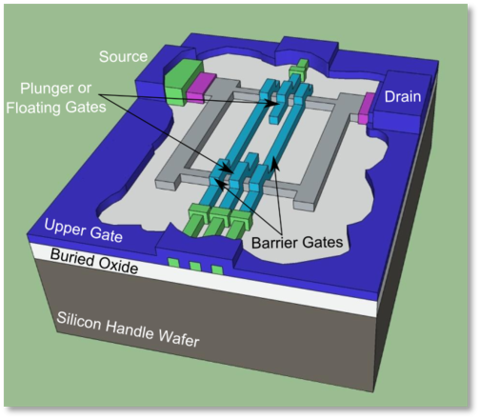Quantum Ampere Standard

The Technology
In the redefined SI, the ampere is based on the elementary charge of a single electron — an extremely small quantity that is a constant of nature. One amp is now defined as the amount of charge carried by 6.24 billion billion electrons past a given point in one second.
The new definition is refreshingly exact. And formidably difficult to use. Devising a device that conforms to the new definition is a demanding task. But progress is being made. The good news is that it is possible to count individual electrons with a tiny device called a single-electron transistor (SET).
A SET uses the same basic structure as an ordinary silicon transistor. It contains a source of electrons, a voltage “gate” that controls their flow, and a drain where the electrons exit and are measured. The difference is that the SET also includes an “island” made from a microscopic quantum dot that enables researchers to move electrons one at a time from the island to the drain, where they are counted.
The distance from source to drain is about one-tenth the width of a human hair, and the electron channels are 10 times smaller. The energies involved are so tiny that that device must be cooled to about 10 thousandths of a degree above absolute zero. The bad news is that the currents involved are awfully feeble. The output of a single SET pump is about one trillionth of an amp.
So work is underway on several prototype designs that can ultimately boost that amount by 10,000 times through an optimal choice of materials, increasing the pump rate to around a billion electrons per second. By running 100 of these SET pumps in series, and amplifying the result, researchers could achieve larger currents.
Combining the electric current from large numbers of SETs may ultimately provide a quantum-accurate measure of the larger amounts of current present in real-world electronic equipment. Eventually, researchers hope to reach about 1 microampere (a millionth of an amp) — within the range needed to develop a practical, working standard for electric current.
Advantages Over Existing Methods
Highly accurate measurements of electric current have been indirect at best and impractical at worst.
Until May 2019, the ampere was defined in the International System of Units (SI) as the amount of current that would produce a specific amount of force between “two straight parallel conductors [wires] of infinite length, of negligible circular cross-section, and placed 1 meter apart in vacuum.” These hypothetical conditions could barely be approximated in even the most sophisticated laboratory settings.
Therefore, the amp has typically been measured by way of its siblings — the volt and the ohm — which are precisely related to the amp through a law of physics. The SET allows for a direct measure of current.
Applications
In addition to its use as an electric current standard, a high-throughput SET pump with low measurement uncertainties could be combined with ultra-miniature standards for voltage or resistance, both of which are now defined with quantum exactitude in terms of fundamental constants of nature. The result would be a single, compact, completely quantum-based measurement suite for all three elements of the “metrology triangle” that could be delivered to factory floors and laboratories — a primary goal of NIST on a Chip.
Key Papers
R. Murray, J.K. Perron, M.D. Stewart Jr., P. See, S.P. Giblin, J.D. Fletcher, M. Kataoka and N.M. Zimmerman. Results and model for single-gate ratchet charge pumping. Journal of Applied Physics. March 2, 2020. DOI: 10.1063/1.5133967
B. Hu, E. Ochoa, D. Sanchez, J. Perron, N.M. Zimmerman and M.D. Stewart Jr. Effect of device design on charge offset drift in Si/SiO2 single electron devices. Journal of Applied Physics. Oct. 9, 2018. DOI: 10.1063/1.5048013
S.S. Kalantre, J.P. Zwolak, S. Ragole, X. Wu, N.M. Zimmerman, M.D. Stewart Jr. and J.M. Taylor. Machine learning techniques for state recognition and auto-tuning in quantum dots. NPJ Quantum Information. Jan. 21, 2019. DOI: 10.1038/s41534-018-0118-7
R. Murray, J.K. Perron, M.D. Stewart Jr. and N.M. Zimmerman. AC Signal Characterization for optimization of a CMOS Single Electron Pump. Nanotechnology. Jan. 8, 2018. DOI: 10.1088/1361-6528/aa9e56
J.K. Perron, M. Gullens, J.M. Taylor, M.D. Stewart Jr. and N.M. Zimmerman. Valley blockade in a silicon double quantum dot. Physical Review B. Nov. 13, 2017. DOI: 10.1103/PhysRevB.96.205302
S.P. Giblin, M. Kataoka, J.D. Fletcher, P. See, T.J.B.M. Janssen, J.P. Griffiths, G.A.C. Jones, I. Farrer and D.A. Ritchie. Towards a quantum representation of the ampere using single electron pumps. Nature Communications. July 3, 2012. DOI: 10.1038/ncomms1935
Contacts
-
(301) 975-4690

